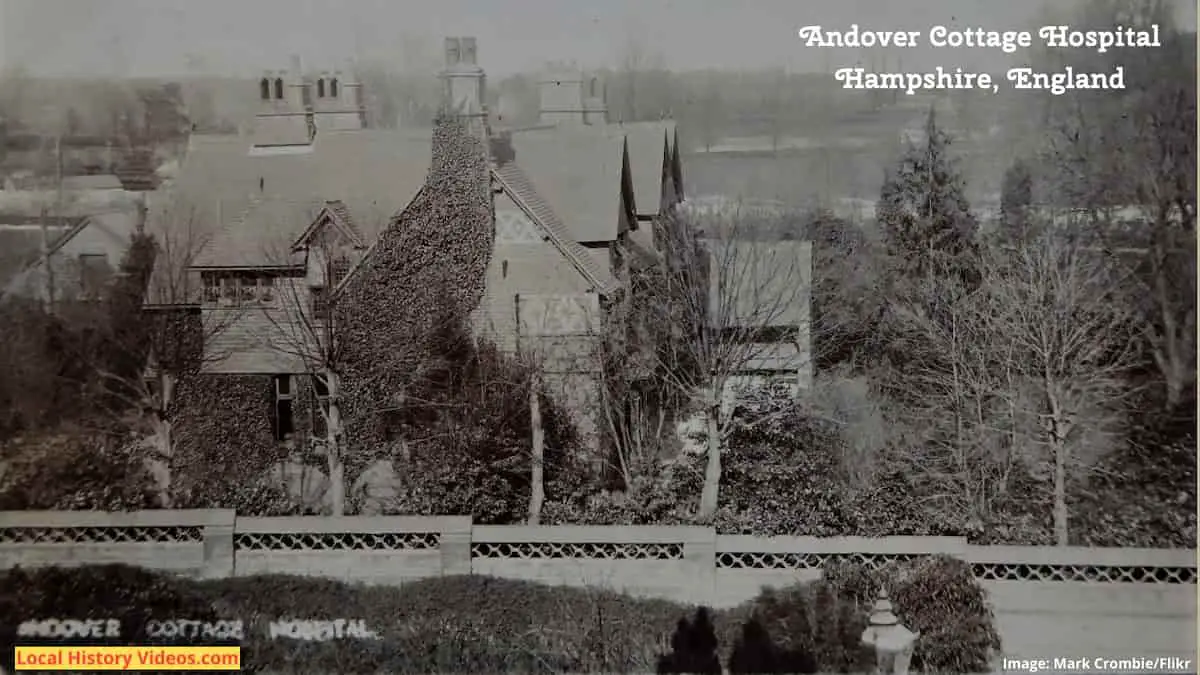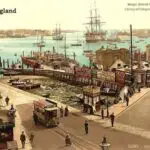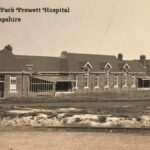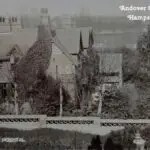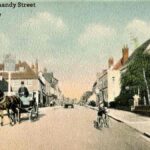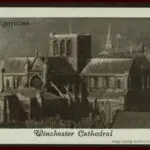Enjoy a glimpse of history through old images of Andover, in Hampshire, England, UK.
German Refugees (1938)
Close to Andover, German-Jewish refugees were training to be agricultural workers, apparently in preparation for their migration as skilled workers overseas.
There were only adult men and women at this camp. The German-Jewish child refugees were at a camp near Harwich.
World War II started the following year.
German Refugees At Andover (1938)- British Pathe on YouTube
Church Bus (1966)
Reverend Apps didn’t have a church near the new housing estates, so held services in a double decker bus.
Double Decker Church (1966) – British Pathe on YouTube
Chantry Way (1989)
In March 1989, David Garside was the manager of Baker’s Sound and Vision Ltd at 39, Chantry Way.
At the time, the town centre was undergoing a lot of redevelopment, so David picked up his home video recorder and over a couple of days filmed the town centre before it changed.
There are several locations included, showing a wide range of businesses, people, and activities.
Andover Town Centre during re-development in March 1989. Chantry Way. Hampshire. Historic views. – David Garside on YouTube
A Bit of Andover History
Extract from:
Post office [afterw.] Kelly’s directory of Hampshire, Dorsetshire, Wiltshire (the Isle of Wight, and the Channel Islands)
by Kelly’s directories, Ltd
Published in 1880
Pages 24 – 25
ANDOVER is an ancient municipal and parliamentary borough, market and union town, and station on the South Western railway, giving name to the hundred, and petty sessional division, and is a polling place for North Hants: it is in the rural deanery of Andover western division, arch deaconry and diocese of Winchester, 66 miles from London, 18 north – east from Salisbury and 19 west from Basingstoke.
The town stands on the river Anton, near the skirts of an extensive tract of woodland bordering on Salisbury plain; it is principally disposed in three broad streets; since the opening or the S.W. railway many new buildings and a district called Neatown have prang up in the vicinity of the station; it is well supplied with water and lighted with gas.
Several packs of hounds are kept in the neighbourhood.
The borough dates its incorporation from the time of King John, and was represented in Parliament in the reign of the first Edward, but afterwards stores its privileges to sleep till the 27th of Elizabeth, from which period it returned two members until 1867, when the “Representation of the People Act ” reduced the number to one.
By the Reform Act, 1832. Foxcotte and Knight’s Enhan were added to the parliamentary borough.
Andover gives the title of Viscount to the Earl of Suffolk.
The corporation consists of a mayor, 4 aldermen and 12 councillors: it has a separate court of quarter sessions and commission of the peace.
A burial board consisting of 7 members was formed in 1869. The cemetery is at the north end of the town, adjoining the church; it is about 4 acres in extent and has a chapel for the use of Nonconformists, and an excellent mortuary.
The church of St. Mary is a handsome and spacious edifice, erected at a cost of nearly £30,000, and at the expense of the late Rev. William Standey Goddard D.D. formerly head master of Winchester College: it is in the Early English style, and consists of chancel, nave and aisles, with a lofty tower (with crocketed pinnacles), which contains a peal of 8 bells and a clock, and is a conspicuous object from all parts of the neighbourhood: the church will hold about 850; the seats are all free: in the galleries are the remains of two curious tombs, taken from the old church, which have been restored, one representing a male and female kneeling, with a tomb between them; the other has on the left the figure of a man seated: on the right are seven figures kneeling; an inscription underneath bears date 1611: there are several very handsome stained windows, two being in memory of the Goddard and Gales families: the organ is a fine one, and stands in a chapel erected from designs by W. White esq. P.S.A. under whose direction the whole church has been thoroughly refitted.
The register dates from the year 1580. The living is a vicarage, with Foxcotte chapelry annexed, tithes commuted at £70, in the gift of Winchester College and held by the Rev. Charles Collier M.A. Trinity College, Dublin and ad eundem of Oxford, F..A. surrogate.
The Free Grammar School, founded in 1500, has an endowment of £20 yearly and a house, where ten boys of the town are educated free of cost: there is also a school for twenty poor children, founded by John Pollen esq. Endowed with a house and £10 a year.
Adjoining the church, a school – house las been erected by Miss M, Gale and endowed with £10,000 £3 per cent. Consols; part is used as an Infant school and the other part as a School of Industry, in which a limited number of girls are maintained, clothed and educated.
Here are likewise National and British schools for boys and girls, and four Dissenting places of worship.
The Baptist chapel is a handsome building of stone and white brick, with two stone porticoes and a circular stained window, built in 1806 by public subscription, at a cost of about £1,100.
The Cottage Hospital in the Junction road is a handsome red brick building; it was erected in 1876, at a cost of over £2,000, chiefly through the liberality of Sir Charles Pressly K.C.B. Henry Thompson esq., and the late Mr. William Gue, and is supported by voluntary contributions.
There are alms houses for six poor men, originally founded in 1686 by John Pollen esq. formerly one of the representatives of this borough; also almshouses for four aged women and another for four women, called Spital Almshouses.
Charities producing £200 are distributed yearly, and another for four women, endowed with 3s. 6d., a week, situate in the Common Acre.
The spacious Town hall, erected in 1825, at a cost of £7,000, stands on arelies and is a stone building in the Classical style; the large room is capable of seating 300 persons and is used for concerts, lectures and meetings; it contains also a council chamber, a bench room for criminal business, and other rooms: the borough sessions are held in it quarterly and the borough magistrates meet on the first and third Monday in the month.
A corn market is held every Friday under the Town hall.
A market for the sale of fat and store stock is held in Bridge street every Monday.
The pig market, on Friday, is held at the Masons ‘ Arms, Winchester street.
There is a sheep fair on the 17th November and a wool fair on the last Friday in June.
The proximity of Weshill fair, about 31 miles west, contributes materially to the commercial prosperity of Andover: this fair, one of the largest in the county, is visited by farmers from almost every part of England. There are also two very considerable sheep fairs held at Appleshaw, 5 miles north – west from Andover.
At the foot of Bury Hill, on the Pillhill Brook, are the Waterloo foundry and ironworks, conducted by Messrs. Tasker and Sons, general engineers, Ironfounders and agricultural implement manufacturers.
There are breweries and two banks.
Catherine Hanson, in 1570, appropriated an acre of ground as a walk, planted with trees, for the recreation of the townspeople.
The Roman road from Winchester to Cirencester passed near Andover, and is still visible in Harewood, near Wherwell; and the Portway crosses this road to the north. A Roman station is supposed to have existed here, a supposition which acquires a probability from the remains of several Roman encampments in the immediate neighbourhood, and of a large one on the summit of Bury Hill, about 2 miles south – west. Folkshury, or Balksbury, is a large camp, 1 mile south – west. The Devil’s Ditel is 3 miles north – west.
On Danebury Hill, a long elevated ridge which terminates in a loity headland overlooking Salisbury, is a complicated circular entrenchment, with very high ramparts; and near it are several barrows, one of them called Canute’s Barrow.
Another camp occupies the summit of Quarley Hill, also on the borders of the plain and 8 miles west from Andover, and various tumuli are scattered over its neighbouring downs.
The Mayor and Corporation are lords of the manor.
The principal landowners are the Earl of Portsmouth, Colonel William Henry Earle, Albemarle Dewar, Frederick Ellen, R. D. Walbey, Alfred Butterworth, William Fowle and J. P. Good esqrs.
The area is 8.300 acres; rateable value. £23,439; the population in 1871 was of the parish and municipal borough, 5,501, and of the parliamentary borough, 5,744, which includes 67 in Foxcotte parish and 176 in Knight’s Enham parish; and of the Local Board district, 4,195.
Parish Clerk & Organist, John William Chuter.
HATHERDEN is a hamlet, 3 miles north. By an order in Council, dated May 7, 1838, all parts of the parish of Andover north of the South Western railway were formed into an independent district, named the district chapelry of Christ Church Smannell with Hatherden: Smannell was separated from Hatherden in 1875. Christ Church is a modern flint and brick building, and consists of chancel and nave, with bell turret and 2 bells. The register dates from the year 1858. The living is a vicarage, yearly value £145 set, in the gift of the Bishop of Winchester and held by the Rev. George Allen Procter M.A. of Trinity College, Dublin. Here is a Free school for 24 poor children of Hatherden and Wildhern, endowed by James Lamboarne in 1725 with £30 a year. The principal landowners are Alfred Butterworth, Colonel Earle & Tomas Child. The area is 2,954 acres; the population in 1871 was 321.
WILDHERN, 3 miles north from Andover, is in this parish;here is a Wesleyan Methodist chapel.
SMANNELL is a hamlet, 23 miles north – east, formed into a separate ecclesiastical parish in 1875. Christ Church, a modern building of flint and brick, consists of nave and north aisle, with bell turret. The living is a vicarage, yearly value £110, in the gift of the Bishop of Winchester and held by the Rev. John Samuel Jones. Here is a National school supported by the Dewar endowment of £20 per annum.
LITTLE LONDON, 34 miles north; and WOOD HOUSE ( or Woodhams ), 3 miles north, are hamlets in the parish of Smannell. The principal landowners are Mrs. Logman, Colonel Earle & Mr. George Thomas Tabor; the area is 2,904 acres; the population in 1871 was 400.
EAST ANTON is 2 miles north; FISKLEY, 3 miles north east; near it are two barrows.
CHARLTON, 13 miles north – west, where there is a place of worship for Primitive Methodists, a Mission hall and a National school, is a hamlet in the parish of Andover.
More Pictures of Old Andover
Old Andover in Hampshire, England, enjoyed through a Pinterest board of historic photos, vintage pictures & archive film. Browse history in these fascinating old images of a bygone era.
More about Hampshire
If you’ve enjoyed this page about Andover’s history, you may be interested in some of these related topics and places:
- Old Images of Hampshire, England
- Old Images of Bordon, Hampshire
- Old Images of Basingstoke, Hampshire
- Old Images of Andover, Hampshire
- Old Images of Alton, Hampshire
- History in Old Images of Winchester, England
- History in Old Images of Portsmouth, England
- Old Images of Southampton, England
- Old Images of the Bygone Port of Southampton
- Old Images of the Army at Aldershot

